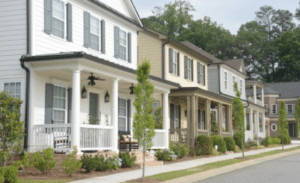The ‘smart home’ is the new ‘internet of things’, or objects that can serve you better by communicating with each other or directly with you through apps on your smart phone. In the ideal version of the wired future, all of our appliances and gadgets talk to each other seamlessly.
What could living in a smart home look like? Picture something like this:
The lights in your bedroom slowly illuminate to quietly awaken you in the morning, replacing the typical blaring alarm. The aroma of fresh brewing coffee drifts in and stirs your senses. Once the lights are all the way up, the heating system kicks on, just in time to warm up your room so you’re not shocked once you crawl out from underneath the duvet.
When you step into the shower, it turns on automatically and remembers your preferred temperature and water pressure. And it will shut off right when you’re finished as it knows how long you take to bathe.
Once you’ve driven out of your garage, your home alarm system arms itself. And it will only unlock automatically when it “sees” and recognizes someone else from your family approaching through programmed in bio-metrics.
Do smart homes really work this way right now? Not exactly…while you may find some of these smart features in certain homes, we haven’t reached the point where every feature intuitively knows what you want and when you wanted. However, each year we’re getting closer and closer toward that shiny, idealized ‘Jetson’ future.
Here are some trends that we see for smart homes, many of which may also help you save money:
Smart Thermostats
Programmable thermostats that are synchronized with the clock have been around for decades. However, they’re often difficult to set and aren’t necessarily efficient; they simply turn on or off as programmed, whether or not you are there.
With the newer models, smart thermostats can be programmed to adjust the temperature when they sense you are present. And once you leave, they can kick back to standby mode so that you’re saving energy and money. Nest does all of this, and it also allows you to check your usage from your cell phone so that you can adjust the temperature remotely and save even more.
Smart Smoke Detectors
Having a working, effective smoke detector saves lives. But unfortunately, many of us still have those battery-run smoke detectors that make that annoying, piercing beep when their batteries are running low on power. And instead of replacing batteries right away, it’s often easier to pull them out and disable the detector (while risking our lives).
Many of the new smart smoke detectors, like the Birdi, monitor smoke, carbon dioxide, as well as air quality. With this new sensor technology, they know the difference between a real fire and burnt toast.
Smart Sprinkler Control
Weather in our area is predictably unpredictable. Often, especially during the summer months, we fall into a severe drought. But then we might have one season that brings extreme amounts of rain, like we did this past spring.
A smart sprinkler controller like Rachio Iro can not only help save you lots of money on your water bill but also help protect our precious resources.
Programmable by computer or smart phone, it can automatically adjust how often you water your lawn based on the season and the weather forecasts. You can also remotely adjust the settings through a mobile app.
Smart Solar Panels
You can put the sun to work for you by using solar technology to power your home. It’s green and renewable, and can save you money over the long term. A recent study conducted by the NC Clean Energy Technology Center determined that Austin customers who invested in a solar system saved an average of $66 per month during the first year that they owned the system.
With smart solar panels, you can program the technology to monitor their performance and even turn them off in case of a weather emergency or fire.
Smart Home Security Systems
Home monitoring has become much more sophisticated in recent years. With the old-style security systems, you had to call in contractors to wire your home with monitoring sensors.
With new smart technology, you can simply place a few smart devices in your home to monitor movement and sense whether doors and windows are closed or opened. Some systems include audio and video monitoring, as well as sirens to scare off intruders. You get real-time feedback on security breaches through an app. And, because you’re alerted as soon as the system senses an intruder, it’s more likely that they will be caught.
Canary is one popular all-in-one audio-video security system, complete with sirens and night vision.
Smart Locks
Go beyond the standard key locks, which can often be compromised by burglars. The new smart lock systems give you more control over those who can gain access to your home.
Some systems, like the Kwikset Kevo, include encrypted virtual keys that you can program for access for a limited amount of time—for example, allowing guests over for a weekend, or cleaning service in during a specific window of time.
Other door locking systems include biometric technology. The Ola Smart Lock allows you to program your lock to recognize your family member’s fingerprints. Other systems use facial recognition to greet you and unlock your door.
The new August Smart Lock integrates with Apple’s technology so you can ask Siri to open your door for you.
Smart lighting systems and light bulbs
A well-lit home feels warm and welcoming, and good lighting can instantly increase the value of your home.
However, annual lighting costs can account for up to 12% of your overall electric bill, or over $200 per year according to Energy Star. You can easily reduce this expense simply by using smart lighting technology to add efficiency.
The Philips Hue wifi-enabled lights make it easy to add to your home without installing specialized equipment. Smart lighting dimmers and sensors can give you more control over how much energy you use and allow you to turn them on and off through your smart phone.
New smart light bulbs can give you control over the warmth or coolness levels of your lighting. With the Lifx LED Light Bulbs, for example, you can program your light bulbs to turn on or off when you want, to slowly wake you up with increasing illumination, or to change from daytime work lighting to entertainment-friendly shades for parties.
Smart Appliances
Programmable slow cookers and coffee makers are the quaint, old-fashioned versions of these home conveniences. Newer, smart appliances give you more control over how your food is kept and prepared, and make it easier for you to complete pesky household chores.
- Newer coffee makers, like the Smarter Coffee Machine, let you ‘order’ your coffee exactly to your liking, adjusting everything from bean grind to temperature to strength to time that it’s ready to drink.
- Smart refrigeration technology can help you store your food at just the right temperature, adjusting the thermostat during peak usage times. For example, the LG THINQ Fridge can alert you via smart phone app if a door is accidentally left open.
- Smart ovens can ensure that your food is cooked to the right level of done-ness, and alert you when your meal is ready to eat. June, a new counter oven invented by former Google, Apple, Go-Pro and Path employees will give you even more control—it will contain cameras, thermometers, and other technology to ‘learn’ what you like to eat and make menu suggestions.
- Smart washers and dryers have customizable controls so that you can safely wash any type of fabric. Some units include controls to increase drying time to save energy. And soon, connected appliances from GE, Oster, Samsung, and other makers, will be able to re-order soap and fabric softener directly from Amazon, so you won’t even have to think about running to the store at the last minute.
Have you tested any of these technologies in your home? Did we miss any of your favorite home technologies? Let us know in the comments!



